Intel Core i7-11700K Review: Blasting Off with Rocket Lake
by Dr. Ian Cutress on March 5, 2021 4:30 PM EST- Posted in
- CPUs
- Intel
- 14nm
- Xe-LP
- Rocket Lake
- Cypress Cove
- i7-11700K
CPU Tests: Office and Science
Our previous set of ‘office’ benchmarks have often been a mix of science and synthetics, so this time we wanted to keep our office section purely on real world performance.
Agisoft Photoscan 1.3.3: link
The concept of Photoscan is about translating many 2D images into a 3D model - so the more detailed the images, and the more you have, the better the final 3D model in both spatial accuracy and texturing accuracy. The algorithm has four stages, with some parts of the stages being single-threaded and others multi-threaded, along with some cache/memory dependency in there as well. For some of the more variable threaded workload, features such as Speed Shift and XFR will be able to take advantage of CPU stalls or downtime, giving sizeable speedups on newer microarchitectures.
For the update to version 1.3.3, the Agisoft software now supports command line operation. Agisoft provided us with a set of new images for this version of the test, and a python script to run it. We’ve modified the script slightly by changing some quality settings for the sake of the benchmark suite length, as well as adjusting how the final timing data is recorded. The python script dumps the results file in the format of our choosing. For our test we obtain the time for each stage of the benchmark, as well as the overall time.

There is a small performance gain here in the real world test across the three generations of Intel processors, however it is still a step away from AMD.
Application Opening: GIMP 2.10.18
First up is a test using a monstrous multi-layered xcf file to load GIMP. While the file is only a single ‘image’, it has so many high-quality layers embedded it was taking north of 15 seconds to open and to gain control on the mid-range notebook I was using at the time.
What we test here is the first run - normally on the first time a user loads the GIMP package from a fresh install, the system has to configure a few dozen files that remain optimized on subsequent opening. For our test we delete those configured optimized files in order to force a ‘fresh load’ each time the software in run. As it turns out, GIMP does optimizations for every CPU thread in the system, which requires that higher thread-count processors take a lot longer to run.
We measure the time taken from calling the software to be opened, and until the software hands itself back over to the OS for user control. The test is repeated for a minimum of ten minutes or at least 15 loops, whichever comes first, with the first three results discarded.
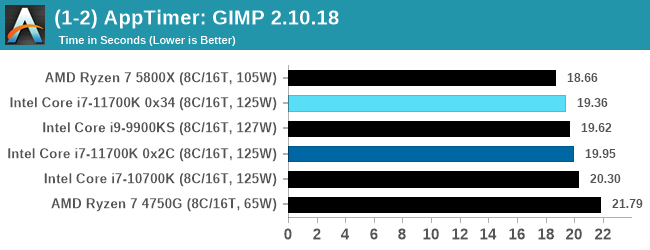
The app initialization test here favors single core performance, and AMD wins despite the lower single thread frequency. The 9900KS has a slight advantage, being a guaranteed 5.0 GHz, but none of the improved IPC from the Cypress Cove seems to come into play here.
Science
In this version of our test suite, all the science focused tests that aren’t ‘simulation’ work are now in our science section. This includes Brownian Motion, calculating digits of Pi, molecular dynamics, and for the first time, we’re trialing an artificial intelligence benchmark, both inference and training, that works under Windows using python and TensorFlow. Where possible these benchmarks have been optimized with the latest in vector instructions, except for the AI test – we were told that while it uses Intel’s Math Kernel Libraries, they’re optimized more for Linux than for Windows, and so it gives an interesting result when unoptimized software is used.
3D Particle Movement v2.1: Non-AVX and AVX2/AVX512
This is the latest version of this benchmark designed to simulate semi-optimized scientific algorithms taken directly from my doctorate thesis. This involves randomly moving particles in a 3D space using a set of algorithms that define random movement. Version 2.1 improves over 2.0 by passing the main particle structs by reference rather than by value, and decreasing the amount of double->float->double recasts the compiler was adding in.
The initial version of v2.1 is a custom C++ binary of my own code, and flags are in place to allow for multiple loops of the code with a custom benchmark length. By default this version runs six times and outputs the average score to the console, which we capture with a redirection operator that writes to file.
For v2.1, we also have a fully optimized AVX2/AVX512 version, which uses intrinsics to get the best performance out of the software. This was done by a former Intel AVX-512 engineer who now works elsewhere. According to Jim Keller, there are only a couple dozen or so people who understand how to extract the best performance out of a CPU, and this guy is one of them. To keep things honest, AMD also has a copy of the code, but has not proposed any changes.
The 3DPM test is set to output millions of movements per second, rather than time to complete a fixed number of movements.
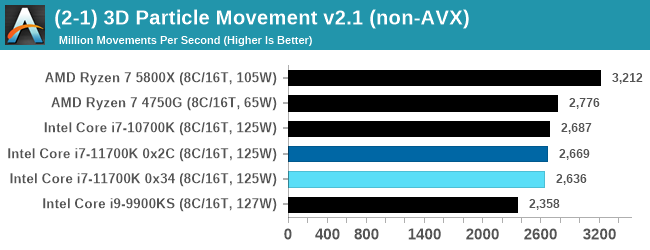
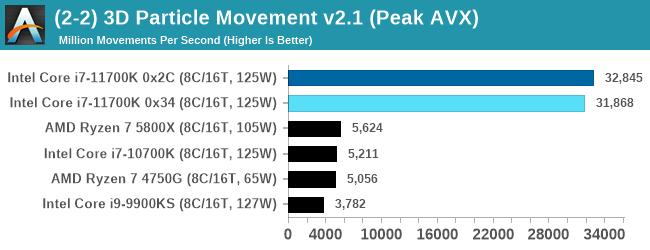
When AVX-512 comes to play, every-one else goes home. Easiest and clearest win for Intel.
y-Cruncher 0.78.9506: www.numberworld.org/y-cruncher
If you ask anyone what sort of computer holds the world record for calculating the most digits of pi, I can guarantee that a good portion of those answers might point to some colossus super computer built into a mountain by a super-villain. Fortunately nothing could be further from the truth – the computer with the record is a quad socket Ivy Bridge server with 300 TB of storage. The software that was run to get that was y-cruncher.
Built by Alex Yee over the last part of a decade and some more, y-Cruncher is the software of choice for calculating billions and trillions of digits of the most popular mathematical constants. The software has held the world record for Pi since August 2010, and has broken the record a total of 7 times since. It also holds records for e, the Golden Ratio, and others. According to Alex, the program runs around 500,000 lines of code, and he has multiple binaries each optimized for different families of processors, such as Zen, Ice Lake, Sky Lake, all the way back to Nehalem, using the latest SSE/AVX2/AVX512 instructions where they fit in, and then further optimized for how each core is built.
For our purposes, we’re calculating Pi, as it is more compute bound than memory bound. In ST and MT mode we calculate 250 million digits.
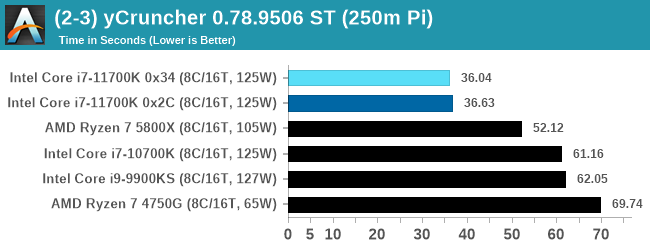
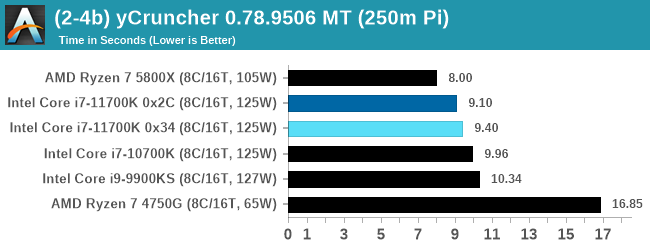
In ST mode, we are more dominated by the AVX-512 instructions, whereas in MT it becomes a mix of memory as well.
NAMD 2.13 (ApoA1): Molecular Dynamics
One of the popular science fields is modeling the dynamics of proteins. By looking at how the energy of active sites within a large protein structure over time, scientists behind the research can calculate required activation energies for potential interactions. This becomes very important in drug discovery. Molecular dynamics also plays a large role in protein folding, and in understanding what happens when proteins misfold, and what can be done to prevent it. Two of the most popular molecular dynamics packages in use today are NAMD and GROMACS.
NAMD, or Nanoscale Molecular Dynamics, has already been used in extensive Coronavirus research on the Frontier supercomputer. Typical simulations using the package are measured in how many nanoseconds per day can be calculated with the given hardware, and the ApoA1 protein (92,224 atoms) has been the standard model for molecular dynamics simulation.
Luckily the compute can home in on a typical ‘nanoseconds-per-day’ rate after only 60 seconds of simulation, however we stretch that out to 10 minutes to take a more sustained value, as by that time most turbo limits should be surpassed. The simulation itself works with 2 femtosecond timesteps. We use version 2.13 as this was the recommended version at the time of integrating this benchmark into our suite. The latest nightly builds we’re aware have started to enable support for AVX-512, however due to consistency in our benchmark suite, we are retaining with 2.13. Other software that we test with has AVX-512 acceleration.
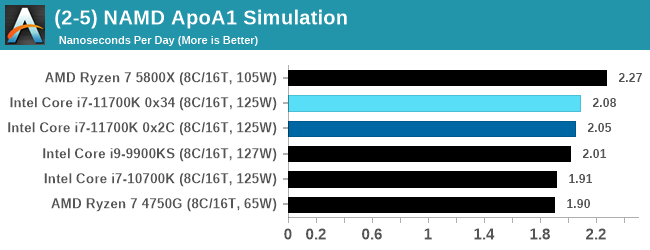
The 11700K shows some improvement over the previous generations of Intel, however it does sit much in the middle of the APU and the Zen 3.
AI Benchmark 0.1.2 using TensorFlow: Link
Finding an appropriate artificial intelligence benchmark for Windows has been a holy grail of mine for quite a while. The problem is that AI is such a fast moving, fast paced word that whatever I compute this quarter will no longer be relevant in the next, and one of the key metrics in this benchmarking suite is being able to keep data over a long period of time. We’ve had AI benchmarks on smartphones for a while, given that smartphones are a better target for AI workloads, but it also makes some sense that everything on PC is geared towards Linux as well.
Thankfully however, the good folks over at ETH Zurich in Switzerland have converted their smartphone AI benchmark into something that’s useable in Windows. It uses TensorFlow, and for our benchmark purposes we’ve locked our testing down to TensorFlow 2.10, AI Benchmark 0.1.2, while using Python 3.7.6.
The benchmark runs through 19 different networks including MobileNet-V2, ResNet-V2, VGG-19 Super-Res, NVIDIA-SPADE, PSPNet, DeepLab, Pixel-RNN, and GNMT-Translation. All the tests probe both the inference and the training at various input sizes and batch sizes, except the translation that only does inference. It measures the time taken to do a given amount of work, and spits out a value at the end.
There is one big caveat for all of this, however. Speaking with the folks over at ETH, they use Intel’s Math Kernel Libraries (MKL) for Windows, and they’re seeing some incredible drawbacks. I was told that MKL for Windows doesn’t play well with multiple threads, and as a result any Windows results are going to perform a lot worse than Linux results. On top of that, after a given number of threads (~16), MKL kind of gives up and performance drops of quite substantially.
So why test it at all? Firstly, because we need an AI benchmark, and a bad one is still better than not having one at all. Secondly, if MKL on Windows is the problem, then by publicizing the test, it might just put a boot somewhere for MKL to get fixed. To that end, we’ll stay with the benchmark as long as it remains feasible.
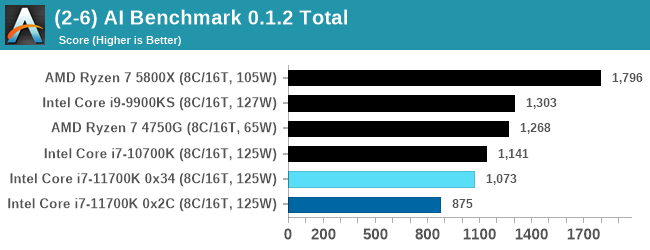
Every generation of Intel seems to regress with AI Benchmark, most likely due to MKL issues. I have previously identified the issue for Intel, however I have not heard of any progress to date.


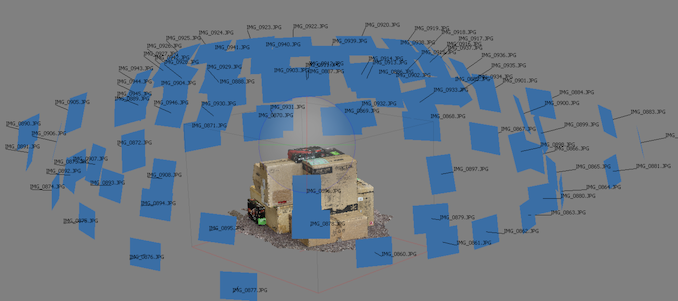

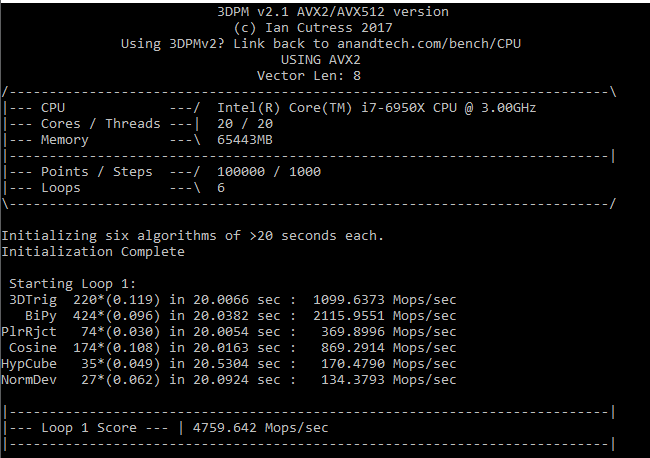
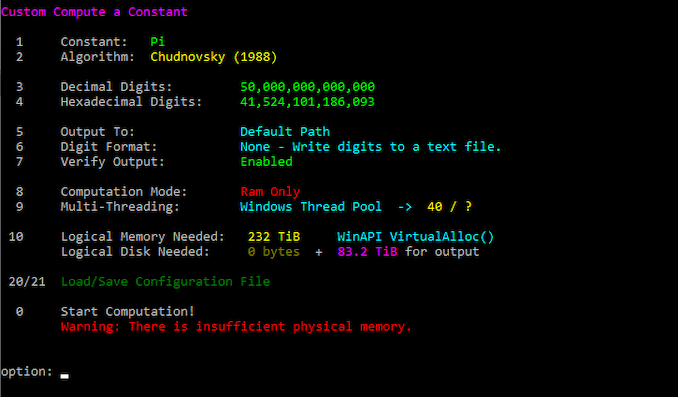
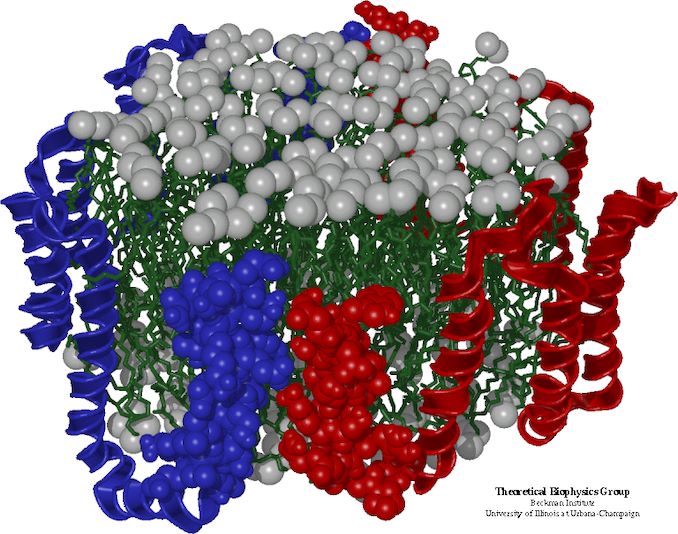









541 Comments
View All Comments
zzzxtreme - Sunday, March 7, 2021 - link
I wished you would have tested the XE graphicsFman4 - Monday, March 8, 2021 - link
Am I the only one find that OP plugged 4 RAMs on an X570 ITX motherboard?Fman4 - Monday, March 8, 2021 - link
@Dr. Ian Cutresszodiacfml - Monday, March 8, 2021 - link
bored. just here to say this is unsurprising though this strongly reminds me of the time where AMD is releasing new, well designed CPUs but two process node generations behind intel. I think AMD was 32nm and 28nm while Intel is 22 and 14nm. most comments were really harsh with AMD but I reasoned that it is simply due to the manufacturing superiority of Intelblppt - Monday, March 8, 2021 - link
Bulldozer and Piledriver are not the examples I would put up for "well designed".GeoffreyA - Tuesday, March 9, 2021 - link
Still, within that mess, AMD did a pretty good job raising Bulldozer's IPC and cutting down its power each generation. But the foundation being fatally flawed, it was hopeless. I believe it taught them a lot about cutting power and so on, and when they poured that into Zen, we saw the result. Bulldozer was a fantastic training ground, if one looks at it humorously.Oxford Guy - Tuesday, March 9, 2021 - link
No, AMD did an extremely poor job.Firstly, Bulldozer had worse IPC than Phenom. No engineers with brains release a CPU to replace the entire line while giving it worse IPC. The trap of going for high clocks was a lesson shown to the entire industry via Netburst. AMD's engineers knew all about it, yet someone at the company decided to try Netburst 2.0.
Secondly, AMD was so sloppy and lazy that Piledriver shipped with a performance regression in AVX. It was worse to use AVX than to not use it. How incredibly incompetent can the company have been? It doesn't take a high IQ to understand that one doesn't ship broken AVX.
AMD then refused to replace Piledriver until Zen came out. It tinkered half-heartedly with APU rubbish and focused on pushing junk like Jaguar.
While it's true that the extreme failure of AMD (the construction core line) is due, to a large degree, to Intel abusing its monopoly to starve AMD of customers and cash — cash it needed to do R&D, one does not release a new chip with worse IPC and then very shortly after break AVX and refuse to stop feeding that junk to customers for many years. Just tinkering with Phenom would have been better (Phenom 3).
As for the foundation claim... we have no idea how well the CMT concept could have worked out with competent engineering. Remember, they literally broke AVX in the Piledriver revision that was supposed to fix Bulldozer enough to make it sellable. Operations caching could have been stronger. The L3 cache was almost as slow as main memory. The RAM controller was weak, just like Phenom's. Etc.
We paid for Intel's monopoly and we're still paying today. Only its monopoly and the lack of adequate competition is enabling the company to be so profitable despite failing so badly. Relying on two companies (or one 1/2, when it comes to R&D money ratio and other factors) to deliver adequate competition doesn't work.
Google and Microsoft = Google owns the clearnet. Apparently, they have some sort of cooperation agreement which helps to explain why Bing has such a tiny index and such a poor-quality search.
TSMC and Samsung = Can't meet demand.
AMD and Nvidia = Nvidia keeps breaking profit records while utterly failing to meet demand. Both companies refuse to stop making their cards attractive for mining and have for a long long time. AMD refused to adequately compete beyond the lower midrange (Polaris forever, or you can buy a 'console'!) for a long time, leaving us to pay through the nose for Nvidia's prices. AMD literally competes against the PC market by pushing the console scam. Consoles are gaming PCs in disguise and they're parasitic in multiple ways, including in terms of wafer allocations. AMD's many many years of refusal to compete with Nvidia beyond the Polaris price point caused so much pent-up demand and now the company can enjoy the artificially high price points from that. It let Nvidia keep raising prices to get consumers used to that. Now that it has finally been forced to improve the 'consoles' beyond the garbage-tier Jaguar CPU it has to offer a bit more value to the PC gaming market. And so, after all these years, we have something decent that one can't buy. I can go on about this so-called competition but why bother. People will go to the most extravagant lengths to excuse the problem of lack of adequate competition — like the person who recently said it's easier to create Google's empire from scratch than it is to make a competitive GPU and sell it as a third GPU company.
There are plenty of other areas in tech with inadequate competition, too.
blppt - Tuesday, March 9, 2021 - link
"AMD then refused to replace Piledriver until Zen came out. It tinkered half-heartedly with APU rubbish and focused on pushing junk like Jaguar."To be fair, AMD had put a LOT of time, money and effort into Bulldozer/Piledriver, and were never a company with bottomless wells of cash to toss an architecture out immediately. Plus, Zen took a long time to design and finalize---thankfully, they made literally ALL the right moves in designing it, including hiring the brilliant Jim Keller.
I think if Zen had been another BD like failure, that would have been the almost the end of AMD in the cpu market (leaving them basically as ATI was) The consoles likely would have gone with Intel or ARM for their next iteration. AMD once again spent tons of money that they don't have as disposable income in designing Zen. Two failures in a row would have been disastrous.
Heck, the consoles might go with their own custom ARM design for PS6/Xbox(whatever) anyways.
GeoffreyA - Wednesday, March 10, 2021 - link
blppt. Agreed, that would have been the end of AMD.Oxford Guy - Wednesday, March 10, 2021 - link
AMD did not put a lot of resources into fixing Bulldozer.It shipped Piledriver with broken AVX and never bothered to replace Piledriver on the desktop until Zen.
Inexcusable. It shipped Steamroller and Excavator in cost-cut mode, cutting cores, cutting clocks, cutting the socket standards, and cutting cache. It used a dense library to save money by keeping the die small and used the inferior 28nm bulk process.
Pathetic in basically every respect.